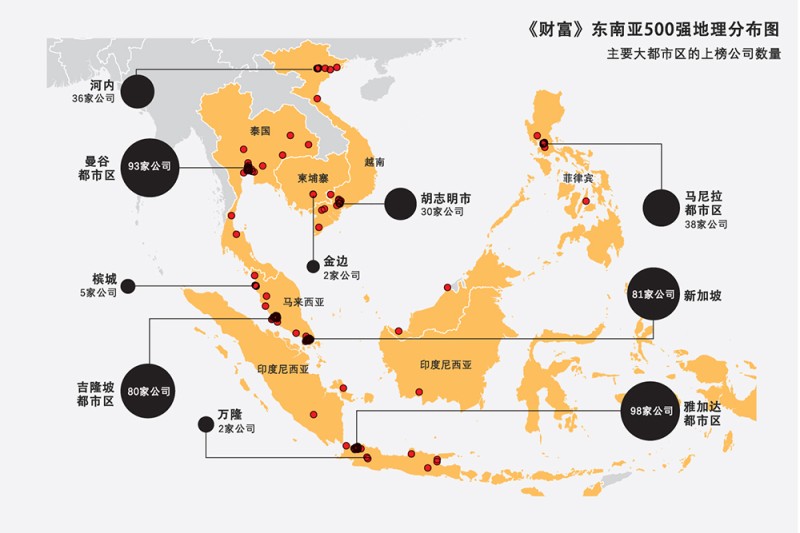今年是《财富》第二次发布东南亚500强榜单,这份按营收排名的该地区规模最大公司年度榜单展现了一个蓄势待发的区域景象:东南亚地区正准备利用全球供应链变革以及采矿、电动汽车和人工智能等蓬勃发展的产业带来的机遇——尽管美国的关税政策可能会使去年的部分增长成果出现倒退。
去年首届《财富》东南亚500强榜单中的七个国家——印度尼西亚、泰国、马来西亚、新加坡、越南、菲律宾和柬埔寨——于今年再度上榜,并持续对该地区的经济产生深远影响。上榜企业的去年总营收达1.82万亿美元,较上年增长1.7%。这一涨幅滞后于榜单覆盖的上述七个经济体所报告的4.1%的GDP增长率。
作为东南亚地区面积最大、经济体量最大的国家,印度尼西亚在东南亚500强中的上榜公司最多(109家);泰国以100家上榜企业位列第二。然而,若按营收衡量,小小的城邦国家新加坡则拔得头筹。总部位于新加坡的公司去年创造了6,371亿美元的营收,略高于该地区总营收的三分之一。
在营收规模上,今年榜单前五名的公司均足以入选去年的《财富》世界500强。这五家公司均经营大宗商品业务,包括金属行业的托克集团(Trafigura)、石油行业的泰国国家石油公司(PTT)和印尼国家石油公司(Pertamina),以及农产品行业的丰益国际(Wilmar)和奥兰集团(Olam)。
印尼国家电力公司(Perusahaan Listrik Negara,PLN)在该榜单中排名第六,这一排位突显了该榜单的另一个特点:能源(无论是资源开采、发电还是电力输送)是东南亚500强的主导行业,创造了近三分之一的地区总营收。泰国能源公司Bangchak营收飙升47%,跻身今年榜单前20名。
《财富》东南亚500强中,最赚钱的三家公司是新加坡的“三大银行”:星展银行(DBS)、华侨银行(OCBC)和大华银行(UOB)。其中,最年轻的星展银行以85亿美元的利润在三者中居首。
尽管数字经济被预测将蓬勃发展,但科技公司在《财富》东南亚500强中占比较小。榜单前20名仅有一家科技公司——电商和游戏公司Sea。科技领域下一家上榜的互联网公司是网约车平台Grab,位列第128位,相比去年的排名攀升了超过20个位次。
但东南亚无法避开最新的科技趋势。榜单上营收增幅最大的公司是马来西亚代工厂NationGate控股(排名第243位),其销售额在过去一年惊人地增长了723%,突破10亿美元。NationGate的故事与AI息息相关:随着马来西亚及东南亚地区试图通过数据中心和新的AI初创企业搭上AI技术快车,NationGate等公司作为英伟达(Nvidia)在该地区组装AI服务器的唯一代工厂将坐享红利。
东南亚500强企业正日益在全球供应链中扮演重要角色——承接从中国转移的制造业产能,这不仅吸引了巨额资本流入,还重塑着全球贸易格局。

以下是本榜单的前十名。
排名 公司名称
1 托克集团(Trafigura Group)
2 泰国国家石油有限公司(PTT)
3 印尼国家石油公司(Pertamina)
4 丰益国际公司(Wilmar International)
5 奥兰集团(Olam Group)
6 印尼国家电力公司(Perusahaan Listrik Negara)
7 星展集团(DBS Group Holdings)
8 CP All
9 生力集团(San Miguel)
10 伟创力(Flex)(*)
完整榜单请见:【https://fortune.com/asia/ranking/southeast-asia-500/2025/】
本文发表于2025年6月/7月刊的《财富》杂志亚洲版,标题为《东南亚格局变迁中的商业巨头》。
译者:刘进龙
审校:汪皓
今年是《财富》第二次发布东南亚500强榜单,这份按营收排名的该地区规模最大公司年度榜单展现了一个蓄势待发的区域景象:东南亚地区正准备利用全球供应链变革以及采矿、电动汽车和人工智能等蓬勃发展的产业带来的机遇——尽管美国的关税政策可能会使去年的部分增长成果出现倒退。
去年首届《财富》东南亚500强榜单中的七个国家——印度尼西亚、泰国、马来西亚、新加坡、越南、菲律宾和柬埔寨——于今年再度上榜,并持续对该地区的经济产生深远影响。上榜企业的去年总营收达1.82万亿美元,较上年增长1.7%。这一涨幅滞后于榜单覆盖的上述七个经济体所报告的4.1%的GDP增长率。
作为东南亚地区面积最大、经济体量最大的国家,印度尼西亚在东南亚500强中的上榜公司最多(109家);泰国以100家上榜企业位列第二。然而,若按营收衡量,小小的城邦国家新加坡则拔得头筹。总部位于新加坡的公司去年创造了6,371亿美元的营收,略高于该地区总营收的三分之一。
在营收规模上,今年榜单前五名的公司均足以入选去年的《财富》世界500强。这五家公司均经营大宗商品业务,包括金属行业的托克集团(Trafigura)、石油行业的泰国国家石油公司(PTT)和印尼国家石油公司(Pertamina),以及农产品行业的丰益国际(Wilmar)和奥兰集团(Olam)。
印尼国家电力公司(Perusahaan Listrik Negara,PLN)在该榜单中排名第六,这一排位突显了该榜单的另一个特点:能源(无论是资源开采、发电还是电力输送)是东南亚500强的主导行业,创造了近三分之一的地区总营收。泰国能源公司Bangchak营收飙升47%,跻身今年榜单前20名。
《财富》东南亚500强中,最赚钱的三家公司是新加坡的“三大银行”:星展银行(DBS)、华侨银行(OCBC)和大华银行(UOB)。其中,最年轻的星展银行以85亿美元的利润在三者中居首。
尽管数字经济被预测将蓬勃发展,但科技公司在《财富》东南亚500强中占比较小。榜单前20名仅有一家科技公司——电商和游戏公司Sea。科技领域下一家上榜的互联网公司是网约车平台Grab,位列第128位,相比去年的排名攀升了超过20个位次。
但东南亚无法避开最新的科技趋势。榜单上营收增幅最大的公司是马来西亚代工厂NationGate控股(排名第243位),其销售额在过去一年惊人地增长了723%,突破10亿美元。NationGate的故事与AI息息相关:随着马来西亚及东南亚地区试图通过数据中心和新的AI初创企业搭上AI技术快车,NationGate等公司作为英伟达(Nvidia)在该地区组装AI服务器的唯一代工厂将坐享红利。
东南亚500强企业正日益在全球供应链中扮演重要角色——承接从中国转移的制造业产能,这不仅吸引了巨额资本流入,还重塑着全球贸易格局。
以下是本榜单的前十名。
排名 公司名称
1 托克集团(Trafigura Group)
2 泰国国家石油有限公司(PTT)
3 印尼国家石油公司(Pertamina)
4 丰益国际公司(Wilmar International)
5 奥兰集团(Olam Group)
6 印尼国家电力公司(Perusahaan Listrik Negara)
7 星展集团(DBS Group Holdings)
8 CP All
9 生力集团(San Miguel)
10 伟创力(Flex)(*)
完整榜单请见:【https://fortune.com/asia/ranking/southeast-asia-500/2025/】
本文发表于2025年6月/7月刊的《财富》杂志亚洲版,标题为《东南亚格局变迁中的商业巨头》。
译者:刘进龙
审校:汪皓
This year’s Southeast Asia 500, Fortune’s second annual ranking of the area’s largest companies by revenue, is a snapshot of a region ready to take advantage of global supply chain shifts and booming industries like mining, EVs, and AI—even as U.S. tariff policy threatens to roll back some of last year’s gains.
Companies on this year’s 500 list generated $1.82 trillion in revenue last year, up 1.7% from the year before. That lags the 4.1% GDP growth reported across the seven economies covered in this ranking: Cambodia, Malaysia, the Philippines, Indonesia, Thailand, Singapore, and Vietnam.
Indonesia, the region’s largest country and economy, has the largest presence on the Southeast Asia 500, with 109 companies; Thailand comes in second with 100. Measure by revenue, however, and the tiny city-state of Singapore takes the lead. Singapore-based companies generated $637.1 billion in revenue last year, just over a third of the region’s total.
The top five companies on this year’s list were big enough in revenue terms to make last year’s Fortune Global 500. They each trade in commodities, whether metals (Trafigura), oil (PTT and Pertamina), or agricultural products (Wilmar and Olam).
No. 6 in revenue this year is Perusahaan Listrik Negara (PLN), Indonesia’s state-owned power company. Its ranking underscores another quality of this list: Energy—whether resource extraction, power generation, or electrical transmission—is the dominant sector on the Southeast Asia 500, generating almost a third of its total revenue. Thai energy company Bangchak breaks into this year’s top 20 with a 47% jump in revenue.
The three most profitable companies on the Southeast Asia 500 are Singapore’s “Big Three” banks: DBS, OCBC, and UOB. DBS, the youngest of the three, takes the lead with $8.5 billion in profits.
Despite predictions of a booming digital economy, tech has a small footprint on the Southeast Asia 500. Just one tech company, the e-commerce and gaming firm Sea, sits in the top 20. The next internet company, ride-hailing platform Grab, ranks much further down the list at No. 128—although it did climb more than 20 spots in 2024.
But Southeast Asia can’t escape the latest tech trends. The biggest revenue jump on the list belongs to Malaysian contract manufacturer NationGate Holdings, No. 243, whose sales jumped by a whopping 723% over the past year, surpassing $1 billion. NationGate’s story is an AI story: As Malaysia and the region try to ride the technology with data centers and new AI startups, companies like NationGate—Nvidia’s sole contract manufacturer in the region, assembling AI servers—stand to benefit.
Together,the Southeast Asia 500 companies are playingan increasinaly important role in global supply chains-capturing manufacturing capacity shifting from China, which is drawing sinificant capital fows andreshaping global trade dynamics.
This article appears in the June/July 2025: Asia issue of Fortune with the headline “The biggest companies in a region in flux.”

